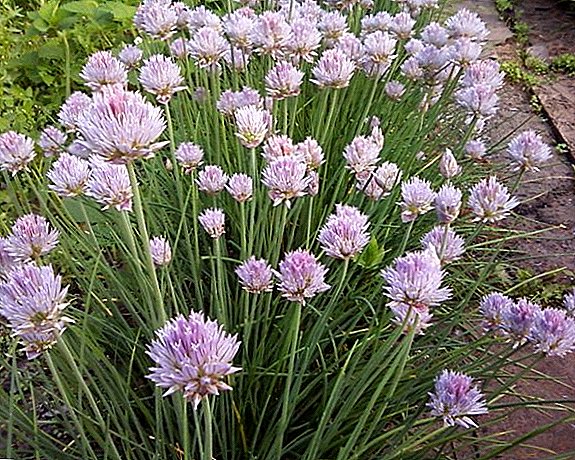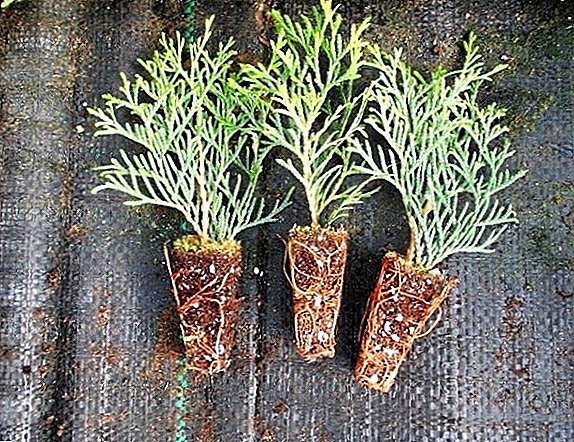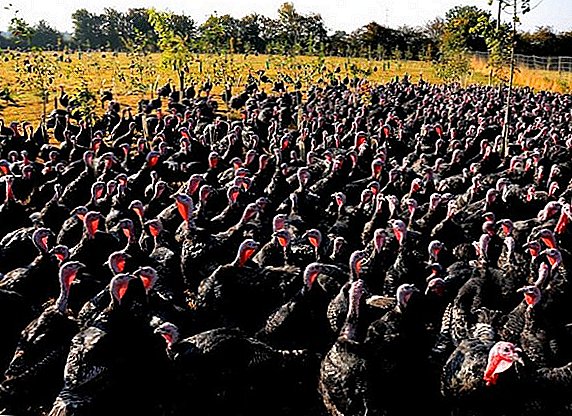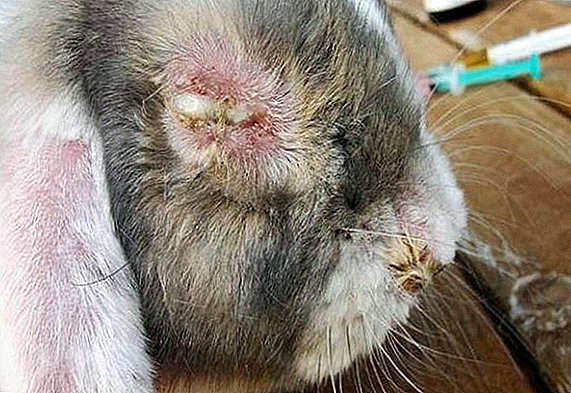 The eye condition of the rabbit is one of the important criteria for the health and well-being of the animal. On a lively, clear look, as well as clean, brilliant and mobile eyes, we can conclude that the four-legged state is in good condition. But with some care errors, injuries or infections, the rabbit's eyes begin to fester. Do not panic - suppuration of the mucous membrane of the eye, although it is a dangerous symptom, but completely treatable with a properly established cause and adequate timely treatment.
The eye condition of the rabbit is one of the important criteria for the health and well-being of the animal. On a lively, clear look, as well as clean, brilliant and mobile eyes, we can conclude that the four-legged state is in good condition. But with some care errors, injuries or infections, the rabbit's eyes begin to fester. Do not panic - suppuration of the mucous membrane of the eye, although it is a dangerous symptom, but completely treatable with a properly established cause and adequate timely treatment.
Why do rabbits' eyes fester?
Eye abscess is not an independent disease: it is always a manifestation of an illness or a dangerous condition. The reasons for the formation of pus in the eyes can be many: starting from an infectious lesion, ending with a banal draft or injury. However, it is necessary to establish the cause of the disease state precisely in order to understand what and how to treat the animal.
Infectious diseases
Purulent discharge is a very common symptom of a viral or bacterial infection. In rabbits, eye suppuration may occur as a result of many ailments, the symptoms and treatment of which will be discussed below.
Myxomatosis
This is an extremely dangerous, highly contagious viral infection with an acute course and high mortality. Mortality during infection can reach 90-100%, which can cause enormous economic damage to the economy.
We recommend to read about how and how to treat myxomatosis of rabbits.
The peak of the disease most often falls at the end of spring - the beginning of summer, although outbreaks of the virus can occur year-round.  For the disease are characterized by such clinical signs:
For the disease are characterized by such clinical signs:
- red spots all over the body;
- severe swelling of the scalp, back, genitals (with a swelling of the head and formation of skin folds in a rabbit, a "lion's appearance" appears);
- the formation of tumor nodules on the skin;
- the development of sero-purulent conjunctivitis (redness and swelling of the eyelids, then purulent discharge leads to the adhesion of the eyes);
- difficulty breathing;
- rhinitis;
- possible development of pneumonia.
Important! This disease is not treatable! All specimens with clinical manifestations and established diagnosis should be slaughtered and disposed of along with all inventory, bedding, feed and manure. Clinically healthy rabbits are allowed to slaughter for meat.
When diagnosing a disease in individual yards or large farms for breeding rabbits, these farms or settlements are declared unfavorable for myxomatosis. To prevent the disease, it is necessary to vaccinate all individuals with a special vaccine against myxomatosis.
It is also very important to destroy in the territory of rodents, ectoparasites, brood sites of harmful insects (flies, mosquitoes, etc.), which in many respects cause the spread of a viral infection. 
Keratitis
Under this diagnosis imply inflammation of the cornea (the transparent part of the outer eye membrane). For the occurrence of keratitis, there are a huge number of factors, the disease can occur in conjunction with other eye (and other) diseases, or in the form of a local inflammatory process.
All causes of keratitis are divided into:
- physical (sun and other burns);
- mechanical (injuries, wounds, bruises, ingress of foreign bodies);
- infectious;
- chemical (exposure to acids, alkalis, cauterizing substances);
- invasive (parasites).
Purulent discharge appears already when the process is running.
Initially, keratitis is manifested by such symptoms:
- redness and clouding of the cornea;
- the formation of a vascular network on the cornea;
- the disappearance of specularity and brilliance;
- squint;
- sensitivity to light;
- tearing;
- film formation.
 To restore the cornea, anti-inflammatory drops and antibiotic-based ointments should be used. For example, you can use the “Barrier” eye drops (3 drops in each eye, 2-3 times a day until the symptoms disappear, but not more than a week) or “Gentalain 0.4%” (the application is similar, but the treatment course is 5 days maximum), "Gentapharm 0.4%."
To restore the cornea, anti-inflammatory drops and antibiotic-based ointments should be used. For example, you can use the “Barrier” eye drops (3 drops in each eye, 2-3 times a day until the symptoms disappear, but not more than a week) or “Gentalain 0.4%” (the application is similar, but the treatment course is 5 days maximum), "Gentapharm 0.4%."Did you know? The opinion that rabbits are a domesticated variant of a hare is fundamentally wrong. Hares and rabbits belong to the same group of Hares, but they are two completely different species with different physiological features and lifestyle. Even more gross mistake is to call rabbits rodents.
Conjunctivitis
The mucous membrane of the eye is called conjunctiva, and its inflammation, respectively, conjunctivitis. The reasons for the occurrence of this disease, as well as keratitis, are many. These can be chemical and mechanical stimuli, bacteria and viruses, avitaminosis, as well as inflammation and infection of other parts of the body that have passed on to the eyes. Conjunctivitis can have several forms, below we will look at its purulent form. 
Suspected purulent conjunctivitis can be on the following clinical picture:
- eyes of the rabbit are constantly closed;
- he tries to scratch them with a paw or rubs his face against objects, shakes his head;
- lacrimation;
- redness and swelling of the eyelids;
- unpleasant smell from the eyelids;
- clumps of pus in the corners, which glue the eyes and turn brown when dried.
The animal needs to be isolated, wash the eyes with a 2% solution of boric acid, then, before each injection of the medicinal preparation, wash the eyes with a solution of Furacilin (1 crushed tablet per 100 ml of hot water). They also need to remove dried crusts. You can apply tetracycline ointment: it is laid with a cotton swab under the eyelid of the animal twice a day until the symptoms disappear.
Important! With inadequate or late treatment of conjunctivitis can lead to partial or complete blindness.You can apply the drops listed above for keratitis, Lacrikan (2 drops three times a day for 8-10 days). If improvement does not occur, you should consult with a veterinarian for the appointment of systemic antibiotics in the form of injections.

Avitaminosis A
Vitamin A performs many functions in the body, in particular, it is responsible for the state of vision and the health of the mucous membranes of the eyes, or rather their barrier protection. With a shortage of this vitamin, the corneal barrier functions weaken, causing inflammation (keratitis, conjunctivitis). To eliminate these diseases, you can use the above schemes.
But it is also important to eliminate the root cause - hypovitaminosis, because you will have to adjust the food: introduce more clover, carrots, alfalfa, which are rich in retinol. Another source of vitamin A is fish oil. The daily rate for young rabbits and toddlers is 0.3-0.5 g, 1-1.5 g is enough for adults, and sucretic females require an increase in the dose to 3-3.5 g.
Familiarize yourself with the causes and methods of treating eye diseases in rabbits.
Dacryocystitis
This diagnosis means blockage (obstruction) of the tear duct. A bacterial infection begins to develop actively in the blocked canal, due to which pus is formed. Dacryocystitis can be an independent disease (mainly in small rabbits) or develop as a concomitant illness in case of dangerous infectious diseases (for example, pasteurellosis).
If in the first case the illness passes on its own as the child grows up and with proper care, then in the second case, if the root cause is not eliminated and only local treatment is applied, the dacryocystitis will become chronic. Also, dacryocystitis can be a complication of dental pathologies, rhinitis, untreated conjunctivitis.
Signs of illness:
- swelling at the site of the tear bag;
- when pressed from the channel stands out a thick, white purulent secret;
- conjunctiva inflamed;
- constriction or complete closure of the eyelid.
Eyes must be washed and dripped with nonsteroidal anti-inflammatory drops. Applying ointments may aggravate the condition. It is also very important to eliminate the root cause, if there is one (cure the animal from infection, remove teeth, etc.). For washing, you can use saline with sodium chloride and the addition of an antibiotic to complete cure.
Read more about how to determine the sex of a rabbit, what affects the lifespan of rabbits, when and how to stigmatize rabbits, how to improve immunity in rabbits, why rabbits grow poorly and do not gain weight, and also find out what to do if the rabbit is fat.
Epiphora
This disease is a bit like the previous one. The main symptom is profuse, incessant tearing. A blockage of the canal, inflammation of the lacrimal sac, blocking of the tear canal by the incisor roots, physiological causes (eyelid turn, incorrect eyelash growth) can cause a painful condition.  Flush the eyes with a solution of Furacilin or saline. Next, give a drop with an antibiotic (Barrier, Gentalayn, etc.).
Flush the eyes with a solution of Furacilin or saline. Next, give a drop with an antibiotic (Barrier, Gentalayn, etc.).
Draft
Rabbits are very cold-resistant creatures, they tolerate low temperatures very well, but are completely defenseless against drafts. Strong streams of cold air can cause tearing, lower immunity, provoking the development of viral or bacterial infections, such as conjunctivitis.
Therefore, when planning the placement of cells, it is necessary to take into account the direction of the winds in your area, to prevent holes and holes in the cells.
It will be helpful for you to learn more about common diseases of the ears in rabbits and their treatment methods.
Mechanical injury
Mechanical damage to the cornea, conjunctiva, or lacrimal canal causes injury. In the absence of treatment with an antiseptic in the wound, an infection causing keratitis and conjunctivitis may develop.
Mechanical damage can occur when wood shavings, sawdust, straws get into the eye, along with which bacteria can get into. In this case, you should regularly inspect the animal and, if any damage is detected, disinfect them immediately. 
Other reasons
To isolate purulent secretions from the eyes, there may be other reasons, which we mentioned indirectly above:
- Malnutrition, vitamin deficiency, deficiency of minerals. As a result of the lack of certain substances that are responsible for immunity, barrier protection, health of the epithelium and mucous membranes, inflammation and suppuration can occur. In this case, you need to adjust the diet and add to it the source products of all the missing nutrients.
- Tooth growth. With the growth of incisors, their roots can crush and block the tear ducts of the eye. Treatment in this case is surgical - a disturbing tooth must be removed.
- Poor care, inadequate conditions. Increased moisture in the cage, poor sanitation, rare replacement of bedding - all this creates favorable factors for the development of bacteria, which can cause pus from the eyes of the rabbit.
Preventive measures
To preserve the health and beauty of the eyes of your rabbits, you need to carry out simple preventive measures, which include:
- Vaccination of rabbits from major infectious diseases, which can be further complicated by ocular inflammations.
- Keeping animals clean, dry (time to clean the cages, change litter material).
- Extermination of rodents and insects on the territory.
- The elimination of drafts.
- Thinking through a balanced diet, in particular, the inclusion of a variety of greens and fish oil.
- If symptoms occur in one individual, isolate it from the rest.
- Elimination of high humidity in the cells.
 It can be concluded that eye suppuration in most cases is a symptom of infectious diseases, but can also occur with poor care, inadequate housing conditions, poor diet, neglect of animals.
It can be concluded that eye suppuration in most cases is a symptom of infectious diseases, but can also occur with poor care, inadequate housing conditions, poor diet, neglect of animals.Did you know? In the Sea of Japan is a small island Okunoshima, which is popularly referred to as the island of rabbits - these creatures are its only inhabitants. According to one version, rabbits in the amount of 8 pieces were once brought here by schoolchildren in the 70s of the last century. Since then, their number has increased to 700, they are not at all afraid of people and are happy to make contact with tourists.Such a seemingly harmless symptom can lead to loss of vision, so when detecting purulent discharge from the eyes of a rabbit, it is necessary to analyze all the factors of maintenance, establish the cause and an accurate diagnosis and conduct appropriate therapy.












